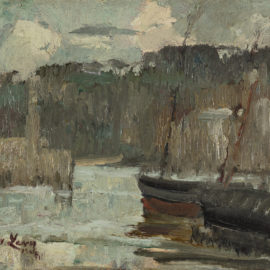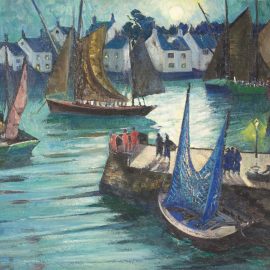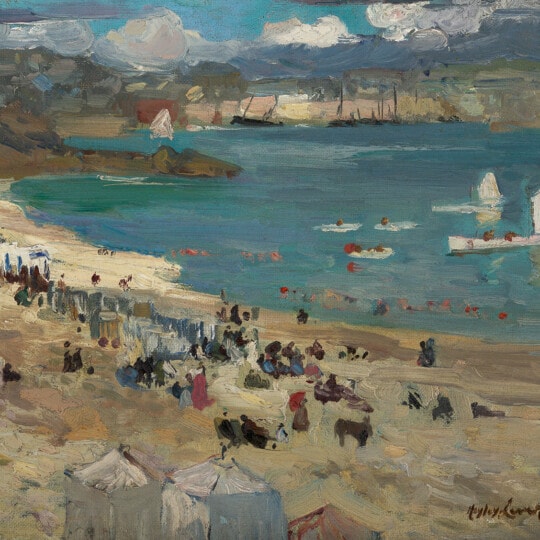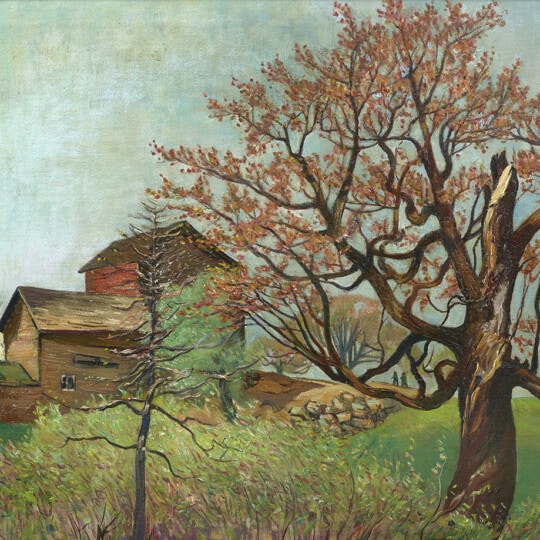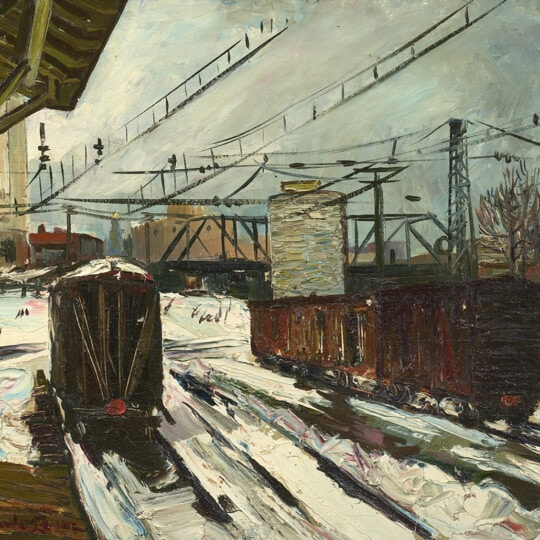Artist Biography
A skilled painter of Post-Impressionist marine and seaport scenes.
By Chelsea DeLay
Art is the re-creation of mood in line, form and color.
—Hayley Lever
I. Biography
II. Chronology
III. Collections
IV. Exhibitions
V. Memberships
VI. Suggested Resources
VII. Notes
I. Biography
Richard Hayley Lever was born on September 28, 1876 in the South Australian town of Adelaide. During his youth, Lever attended Prince Alfred College, where his rudimentary artistic talent caught the eye of art instructor James Ashton. A painter himself, Ashton became a faculty mentor to Lever, instilling in him an appreciation for draftsmanship and drawing.[2] After his graduation in 1891, Lever made up his mind to
A skilled painter of Post-Impressionist marine and seaport scenes.
By Chelsea DeLay
Art is the re-creation of mood in line, form and color.
—Hayley Lever
I. Biography
II. Chronology
III. Collections
IV. Exhibitions
V. Memberships
VI. Suggested Resources
VII. Notes
I. Biography
Richard Hayley Lever was born on September 28, 1876 in the South Australian town of Adelaide. During his youth, Lever attended Prince Alfred College, where his rudimentary artistic talent caught the eye of art instructor James Ashton. A painter himself, Ashton became a faculty mentor to Lever, instilling in him an appreciation for draftsmanship and drawing.[2] After his graduation in 1891, Lever made up his mind to follow in the path of his instructor and enrolled as a student at Ashton’s Academy of the Arts. Upon the advice of Ashton, Lever left Australia to venture to England, with St. Ives in mind as his specific destination.
As a popular artist colony founded during the early 1880s, the rocky cliffs, sandy beaches, and cobbled streets of St. Ives provided an alluring backdrop for many aspiring marine painters, and Lever was no exception. Arriving at the English seaport just before the turn of the century, Lever wasted no time in making friends at the Sloop Inn, the local watering hole for visiting artists.[3] He soon joined the St. Ives Artist Colony, and enrolled at the Cornish School of Landscape, Figure and Sea Painting, where he began to develop his painting techniques under the instruction of Julius Olsson and Algernon Talmage.[4]
Olsson was quick to encourage Lever to try his hand at night-time scenes, which resulted in luminescent works such as Harbor by Moonlight (ca. 1910), while the practice of painting en plein air was championed by Talmage, a master of tonalist landscapes. Lever recognized that his time spent at St. Ives laid the foundation that would influence the rest of his artistic career. He described his time there, stating: “I really worked there. I did not quire realize then how much my future depended upon those days when I studied diligently from morning to night.”[5]
Around 1906, Lever determinedly set off to tour several of Europe’s thriving artistic communities; he painted the French streets of Concarneau, and captured the watery canals found in Bruges, Belgium. Perhaps one of the most significant shifts in Lever’s style occurred as a result of his 1908 trip to the continent, where his encounter with the bold strokes and bright colors of Vincent Van Gogh left quite a lasting impression.[6] In addition to a tribute work entitled Van Gogh’s Hospital (1908), Lever’s absorption of Van Gogh’s style can be seen through his incorporation of flattened, Japanese-influenced forms; brighter colors; and an increase of self portraits.
At the beginning of 1912, Lever immigrated to America, where his Cornish works were quick to gain notoriety in the New York art scene. The year of 1914 proved to be a monumental highlight in Lever’s career; he was awarded the silver medal by the National Arts Club, and went on to receive the Carnegie prize from the National Academy of Design.[7] By 1915, Lever was widely known throughout New York City, and began exhibiting regularly at Macbeth Gallery. That same summer, he traveled to Gloucester, Massachusetts in an attempt to revisit an atmosphere that would remind him of his previous homes in both Adelaide and St. Ives.
Lever became a fully naturalized citizen of the United States in 1921, and by this point, his works successfully conveyed a post-impressionist sense of structural mass and volume that was enhanced through rhythmic contour lines which brought his paintings to life. Up until the 1930s, Lever was a summer school instructor for the Art Students League in upstate New York. When the Depression hit, Lever was one of the countless Americans left in financial ruin. When he became the director of the Studio Art Club in 1938, his style had reverted back to a gloomy expressionism that recalled his earlier influence of Van Gogh.[8]
His unfortunate circumstances only seemed to worsen during the 1940s, when Lever was plagued with a debilitating arthritis. He spent several years in a nursing home in upstate New York, and passed away at Mount Vernon Hospital on December 6, 1958.
II. Chronology
1876 Born September 28 in Adelaide, Australia
1883–91 Attended Prince Alfred College, with drawing instructor was marine painter James Ashton
1891–93 Attended Ashton’s Academy of Arts in Adelaide, Australia
1894–95 Went to London to study art, funded by an inheritance left by his grandmother
Late 1890s Traveled to Paris to study figure drawing on two different occasions
1899 Relocated to the artist colony of St. Ives, along England’s Cornish seacoast
1904 First exhibit at the Royal Academy of Arts, showed Eventide, St. Ives Harbour
1904 Visited Paris, stoped for six months at Capetown, South Africa, while en route to Adelaide
1905 Returned to St. Ives
1906 Married Aida Smith Gale
1908 Traveled to France, Holland and Belgium; exposed to the works of Vincent Van Gogh
Elected to the Royal Society of British Artists
1912 Moved to the United States, settled in New York
1913 Elected membership to the National Arts Club in New York
1915 Spent time in the harbor town of Gloucester, Massachusetts
1921 Became a naturalized citizen of the United States
1922 Spent the summer teaching at the Arts Students League in Woodstock, New York
1924 Received commission to paint the presidential yacht, “The Mayflower,” which was later presented to President Coolidge and installed in the Cabinet Room of the White House
1927 Vacationed in Europe: Visited Cornwall, Paris, Normandy, and Brittany
1930s Established a studio in New York City; continued to paint and teach art classes at the Newark Art Club
1930–31 Taught at the Art Students League summer school in East Gloucester, Massachusetts
1933 Elected Academician of the National Academy of Design; Served as director of the Green Mountain Summer Art School in Stowe, Vermont
1934–35 Taught painting classes at the Forum School of Art in Bronxville, New York
1938 Appointed director of the Studio Art Club while living in Mount Vernon, New York
1940 Traveled to Nova Scotia and Grand Manan Island, Canada
1949 Received the Robert Adriance Birch Award for his participation in the Studio Arts Club; His wife, Aida, died in March
1954 Confined to a nursing home in Mount Vernon, New York
1958 Passed away at Mount Vernon Hospital on December 6
III. Collections
Addison Gallery of American Art, MA
Antioch College, OH
Art Gallery of New South Wales, Sydney, Australia
Art Gallery of South Australia, Adelaide
Baltimore Museum of Art, MD
Benalla Art Gallery, Victoria, Australia
Brigham Young University Museum of Art, UT
Brooklyn Museum, NY
Butler Institute of American Art, OH
Cape Ann Museum, MA
Cheekwood Museum of Art, TN
Cheltenham Art Gallery and Museum, England
Colby College Museum of Art, ME
Corcoran Gallery of Art, Washington, DC
Dallas Museum of Fine Arts, TX
Des Moines Art Museum, IA
Detroit Institute of Art, MI
Duquesne Club, PA
Everson Museum of Art, NY
Flint Institute of Arts, MI
Fogg Art Museum, Harvard University, MA
Ft. Worth Museum of Art, TX
Grand Rapids Art Museum, MI
Heckscher Museum, NY
High Museum of Art, GA
Huntington Museum of Art, NY
Little Rock Art Museum, AR
Los Angeles Museum of Art, CA
Mead Art Museum, MA
Memorial Art Gallery, University of Rochester, NY
Memphis Art Museum, TN
Metropolitan Museum of Art, NY
Montclair Art Museum, NJ
Museum of Art at Brigham Young University, UT
Museum of the City of New York, NY
Nantucket Historical Association, MA
National Academy of Design, NY
National Arts Club, NY
Neuberger Museum of Art, NY
New Britain Museum of American Art, CT
New Jersey State Museum, NH
Norton Museum of Art, FL
Pennsylvania Academy of the Fine Arts, PA
Perth Amboy Public Library, NJ
Prince Alfred College Collection, Kent Town, South Australia
Royal Cornwall Museum, England
Salt Lake City University Museum, UT
Sheldon Museum of Art, NE
Spencer Museum of Art, KS
Springfield Association of Art, UT
Sydney Art Museum, Australia
Telfair Museum of Art, GA
The Canton Museum of Art, OH
The Hudson River Museum, NY
The Parthenon, TN
The Phillips Collection, Washington, DC
The Smithsonian American Art Museum, Washington, DC
University of Nebraska, NE
Westmoreland Museum of American Art, PA
White House, Washington, DC
Whitney Museum of American Art, NY
Wichita Art Museum, KS
Woodstock Art Association, NY
Yale University Art Gallery, CT
IV. Exhibitions (+solo exhibitions)
1910 Carnegie International, PA
1913–32 Pennsylvania Academy of the Fine Arts Annual, gold medal, 1917; gold medal, 1926
1913 Carnegie Institute Annual, Honorable Mention
1914–41 Corcoran Gallery Biennials (12 times)
1914 National Arts Club, NY, silver medal
1914 National Academy of Design, Carnegie Prize
Memorial Art Gallery, NY
Syracuse Museum of Fine Arts, NY
1915 Panama-Pacific International Exposition, gold medal
+City Club, NY
Macbeth Gallery, NY, solo and group exhibitions
National Arts Club, NY, gold medal
1916 National Arts Club, NY, gold medal
+Daniel Gallery, NY
Gallery-on-the-Moors, MA, Inaugural Exhibition
1917 +Daniel Gallery, NY
Detroit Museum of Art, MI
1918 Philadelphia Watercolor Club, PA, prizes
+Daniel Gallery, NY
1920 Macbeth Gallery, NY
Buffalo Fine Arts Academy, NY
Albright Art Gallery, MA
1921 Toledo Museum of Art, OH
Memorial Art Gallery, NY
Syracuse Museum of Fine Arts, NY
1922 National Arts Club, NY, fourth prize
Macbeth Gallery, NY
1923 Schertse Studios, MA
1924 Anderson Galleries, NY
Corcoran Gallery of Art, Washington, DC
1925 +Milch Galleries, NY
+Art Students League, NY
1926 Sesquicentennial International Exposition, PA, bronze medal
1928 +Macbeth Gallery, NY
Ninth Olympiad, Amsterdam, bronze medal
National Arts Club, NY, J. Frederick Talcott purchase prize
1929 +Syracuse Museum of Fine Arts, NY
Art Gallery of Toronto, Canada
+Milch Galleries, NY
Clayton-Liberatore Gallery, NY
1930 Montclair Art Association, NJ
1931 +G.R.D. Studio, NY
Balzac Galleries, NY
1936 National Academy of Design, NY
1938 National Academy of Design, NY
1940 Pennsylvania Academy of the Fine Arts Annual, PA
National Arts Club, NY
1941 New Rochelle Art Association, NY, prizes
Art Institute of Chicago, IL
1920 Society of Independent Artists, NY
1936 Newark Art Club, NJ, prizes
National Academy of Design, NY, Edwin Palmer Memorial Prize
1937 +Macbeth Gallery, NY
1939 National Academy of Design, NY, Edwin Palmer Memorial Prize
1940 National Art Club, prizes
1941 New Rochelle Art Association, NY, medals
1945 +Ferargil Galleries, NY
Westchester Arts and Crafts Club, NY, prizes
V. Memberships
American Painters and Engravers
Art Students League, 1919–1931, instructor
Connecticut Academy of Fine Arts
National Academy of Design, Associate,1925; Academician, 1933
National Arts Club, 1913
Royal British Artists, 1908
Royal Institution of Oil Painters, London
Royal West of England Academy
St. Ives Arts Club
Whitney Studio Club, charter member, 1918
Woodstock Art Association
VI. Suggested Resources
Falk, Peter H. Who Was Who in American Art. (Madison, Connecticut: Sound View Press, 1999), 2005.
Lowrey, Carol. Hayley Lever (1876–1958). New York: Spanierman Gallery, LLC, 2003, 8.
———. Hayley Lever and the Modern Spirit. New York: Spanierman Gallery, LLC, 2010, 9.
VII. Notes
1. “Paris in Jersey Found In Home of Caldwell Artist,” Newark Evening News (14 August 1936).
2. Carol Lowrey, Hayley Lever (1876–1958) (New York: Spanierman Gallery, LLC, 2003), 8.
3. Carol Lowrey, Hayley Lever and the Modern Spirit (New York: Spanierman Gallery, LLC, 2010), 9.
4. Ibid.
5. “St. Ives in America,” St. Ives Times (19 September 1924): 10.
6. Carol Lowrey, Hayley Lever and the Modern Spirit, 13.
7. Hayley Lever, N.A. (New York: Kennedy Galleries, Inc., 1965), 3.
8. Carol Lowrey, Hayley Lever (1876–1958), 22.
A skilled painter of Post-Impressionist marine and seaport scenes.
By Chelsea DeLay
Art is the re-creation of mood in line, form and color.
—Hayley Lever
I. Biography
II. Chronology
III. Collections
IV. Exhibitions
V. Memberships
VI. Suggested Resources
VII. Notes
I. Biography
Richard Hayley Lever was born on September 28, 1876 in the South Australian town of Adelaide. During his youth, Lever attended Prince Alfred College, where his rudimentary artistic talent caught the eye of art instructor James Ashton. A painter himself, Ashton became a faculty mentor to Lever, instilling in him an appreciation for draftsmanship and drawing.[2] After his graduation in 1891, Lever made up his mind to follow in the path of his instructor and enrolled as a student at Ashton’s Academy of the Arts. Upon the advice of Ashton, Lever left Australia to venture to England, with St. Ives in mind as his specific destination.
As a popular artist colony founded during the early 1880s, the rocky cliffs, sandy beaches, and cobbled streets of St. Ives provided an alluring backdrop for many aspiring marine painters, and Lever was no exception. Arriving at the English seaport just before the turn of the century, Lever wasted no time in making friends at the Sloop Inn, the local watering hole for visiting artists.[3] He soon joined the St. Ives Artist Colony, and enrolled at the Cornish School of Landscape, Figure and Sea Painting, where he began to develop his painting techniques under the instruction of Julius Olsson and Algernon Talmage.[4]
Olsson was quick to encourage Lever to try his hand at night-time scenes, which resulted in luminescent works such as Harbor by Moonlight (ca. 1910), while the practice of painting en plein air was championed by Talmage, a master of tonalist landscapes. Lever recognized that his time spent at St. Ives laid the foundation that would influence the rest of his artistic career. He described his time there, stating: “I really worked there. I did not quire realize then how much my future depended upon those days when I studied diligently from morning to night.”[5]
Around 1906, Lever determinedly set off to tour several of Europe’s thriving artistic communities; he painted the French streets of Concarneau, and captured the watery canals found in Bruges, Belgium. Perhaps one of the most significant shifts in Lever’s style occurred as a result of his 1908 trip to the continent, where his encounter with the bold strokes and bright colors of Vincent Van Gogh left quite a lasting impression.[6] In addition to a tribute work entitled Van Gogh’s Hospital (1908), Lever’s absorption of Van Gogh’s style can be seen through his incorporation of flattened, Japanese-influenced forms; brighter colors; and an increase of self portraits.
At the beginning of 1912, Lever immigrated to America, where his Cornish works were quick to gain notoriety in the New York art scene. The year of 1914 proved to be a monumental highlight in Lever’s career; he was awarded the silver medal by the National Arts Club, and went on to receive the Carnegie prize from the National Academy of Design.[7] By 1915, Lever was widely known throughout New York City, and began exhibiting regularly at Macbeth Gallery. That same summer, he traveled to Gloucester, Massachusetts in an attempt to revisit an atmosphere that would remind him of his previous homes in both Adelaide and St. Ives.
Lever became a fully naturalized citizen of the United States in 1921, and by this point, his works successfully conveyed a post-impressionist sense of structural mass and volume that was enhanced through rhythmic contour lines which brought his paintings to life. Up until the 1930s, Lever was a summer school instructor for the Art Students League in upstate New York. When the Depression hit, Lever was one of the countless Americans left in financial ruin. When he became the director of the Studio Art Club in 1938, his style had reverted back to a gloomy expressionism that recalled his earlier influence of Van Gogh.[8]
His unfortunate circumstances only seemed to worsen during the 1940s, when Lever was plagued with a debilitating arthritis. He spent several years in a nursing home in upstate New York, and passed away at Mount Vernon Hospital on December 6, 1958.
II. Chronology
1876 Born September 28 in Adelaide, Australia
1883–91 Attended Prince Alfred College, with drawing instructor was marine painter James Ashton
1891–93 Attended Ashton’s Academy of Arts in Adelaide, Australia
1894–95 Went to London to study art, funded by an inheritance left by his grandmother
Late 1890s Traveled to Paris to study figure drawing on two different occasions
1899 Relocated to the artist colony of St. Ives, along England’s Cornish seacoast
1904 First exhibit at the Royal Academy of Arts, showed Eventide, St. Ives Harbour
1904 Visited Paris, stoped for six months at Capetown, South Africa, while en route to Adelaide
1905 Returned to St. Ives
1906 Married Aida Smith Gale
1908 Traveled to France, Holland and Belgium; exposed to the works of Vincent Van Gogh
Elected to the Royal Society of British Artists
1912 Moved to the United States, settled in New York
1913 Elected membership to the National Arts Club in New York
1915 Spent time in the harbor town of Gloucester, Massachusetts
1921 Became a naturalized citizen of the United States
1922 Spent the summer teaching at the Arts Students League in Woodstock, New York
1924 Received commission to paint the presidential yacht, “The Mayflower,” which was later presented to President Coolidge and installed in the Cabinet Room of the White House
1927 Vacationed in Europe: Visited Cornwall, Paris, Normandy, and Brittany
1930s Established a studio in New York City; continued to paint and teach art classes at the Newark Art Club
1930–31 Taught at the Art Students League summer school in East Gloucester, Massachusetts
1933 Elected Academician of the National Academy of Design; Served as director of the Green Mountain Summer Art School in Stowe, Vermont
1934–35 Taught painting classes at the Forum School of Art in Bronxville, New York
1938 Appointed director of the Studio Art Club while living in Mount Vernon, New York
1940 Traveled to Nova Scotia and Grand Manan Island, Canada
1949 Received the Robert Adriance Birch Award for his participation in the Studio Arts Club; His wife, Aida, died in March
1954 Confined to a nursing home in Mount Vernon, New York
1958 Passed away at Mount Vernon Hospital on December 6
III. Collections
Addison Gallery of American Art, MA
Antioch College, OH
Art Gallery of New South Wales, Sydney, Australia
Art Gallery of South Australia, Adelaide
Baltimore Museum of Art, MD
Benalla Art Gallery, Victoria, Australia
Brigham Young University Museum of Art, UT
Brooklyn Museum, NY
Butler Institute of American Art, OH
Cape Ann Museum, MA
Cheekwood Museum of Art, TN
Cheltenham Art Gallery and Museum, England
Colby College Museum of Art, ME
Corcoran Gallery of Art, Washington, DC
Dallas Museum of Fine Arts, TX
Des Moines Art Museum, IA
Detroit Institute of Art, MI
Duquesne Club, PA
Everson Museum of Art, NY
Flint Institute of Arts, MI
Fogg Art Museum, Harvard University, MA
Ft. Worth Museum of Art, TX
Grand Rapids Art Museum, MI
Heckscher Museum, NY
High Museum of Art, GA
Huntington Museum of Art, NY
Little Rock Art Museum, AR
Los Angeles Museum of Art, CA
Mead Art Museum, MA
Memorial Art Gallery, University of Rochester, NY
Memphis Art Museum, TN
Metropolitan Museum of Art, NY
Montclair Art Museum, NJ
Museum of Art at Brigham Young University, UT
Museum of the City of New York, NY
Nantucket Historical Association, MA
National Academy of Design, NY
National Arts Club, NY
Neuberger Museum of Art, NY
New Britain Museum of American Art, CT
New Jersey State Museum, NH
Norton Museum of Art, FL
Pennsylvania Academy of the Fine Arts, PA
Perth Amboy Public Library, NJ
Prince Alfred College Collection, Kent Town, South Australia
Royal Cornwall Museum, England
Salt Lake City University Museum, UT
Sheldon Museum of Art, NE
Spencer Museum of Art, KS
Springfield Association of Art, UT
Sydney Art Museum, Australia
Telfair Museum of Art, GA
The Canton Museum of Art, OH
The Hudson River Museum, NY
The Parthenon, TN
The Phillips Collection, Washington, DC
The Smithsonian American Art Museum, Washington, DC
University of Nebraska, NE
Westmoreland Museum of American Art, PA
White House, Washington, DC
Whitney Museum of American Art, NY
Wichita Art Museum, KS
Woodstock Art Association, NY
Yale University Art Gallery, CT
IV. Exhibitions (+solo exhibitions)
1910 Carnegie International, PA
1913–32 Pennsylvania Academy of the Fine Arts Annual, gold medal, 1917; gold medal, 1926
1913 Carnegie Institute Annual, Honorable Mention
1914–41 Corcoran Gallery Biennials (12 times)
1914 National Arts Club, NY, silver medal
1914 National Academy of Design, Carnegie Prize
Memorial Art Gallery, NY
Syracuse Museum of Fine Arts, NY
1915 Panama-Pacific International Exposition, gold medal
+City Club, NY
Macbeth Gallery, NY, solo and group exhibitions
National Arts Club, NY, gold medal
1916 National Arts Club, NY, gold medal
+Daniel Gallery, NY
Gallery-on-the-Moors, MA, Inaugural Exhibition
1917 +Daniel Gallery, NY
Detroit Museum of Art, MI
1918 Philadelphia Watercolor Club, PA, prizes
+Daniel Gallery, NY
1920 Macbeth Gallery, NY
Buffalo Fine Arts Academy, NY
Albright Art Gallery, MA
1921 Toledo Museum of Art, OH
Memorial Art Gallery, NY
Syracuse Museum of Fine Arts, NY
1922 National Arts Club, NY, fourth prize
Macbeth Gallery, NY
1923 Schertse Studios, MA
1924 Anderson Galleries, NY
Corcoran Gallery of Art, Washington, DC
1925 +Milch Galleries, NY
+Art Students League, NY
1926 Sesquicentennial International Exposition, PA, bronze medal
1928 +Macbeth Gallery, NY
Ninth Olympiad, Amsterdam, bronze medal
National Arts Club, NY, J. Frederick Talcott purchase prize
1929 +Syracuse Museum of Fine Arts, NY
Art Gallery of Toronto, Canada
+Milch Galleries, NY
Clayton-Liberatore Gallery, NY
1930 Montclair Art Association, NJ
1931 +G.R.D. Studio, NY
Balzac Galleries, NY
1936 National Academy of Design, NY
1938 National Academy of Design, NY
1940 Pennsylvania Academy of the Fine Arts Annual, PA
National Arts Club, NY
1941 New Rochelle Art Association, NY, prizes
Art Institute of Chicago, IL
1920 Society of Independent Artists, NY
1936 Newark Art Club, NJ, prizes
National Academy of Design, NY, Edwin Palmer Memorial Prize
1937 +Macbeth Gallery, NY
1939 National Academy of Design, NY, Edwin Palmer Memorial Prize
1940 National Art Club, prizes
1941 New Rochelle Art Association, NY, medals
1945 +Ferargil Galleries, NY
Westchester Arts and Crafts Club, NY, prizes
V. Memberships
American Painters and Engravers
Art Students League, 1919–1931, instructor
Connecticut Academy of Fine Arts
National Academy of Design, Associate,1925; Academician, 1933
National Arts Club, 1913
Royal British Artists, 1908
Royal Institution of Oil Painters, London
Royal West of England Academy
St. Ives Arts Club
Whitney Studio Club, charter member, 1918
Woodstock Art Association
VI. Suggested Resources
Falk, Peter H. Who Was Who in American Art. (Madison, Connecticut: Sound View Press, 1999), 2005.
Lowrey, Carol. Hayley Lever (1876–1958). New York: Spanierman Gallery, LLC, 2003, 8.
———. Hayley Lever and the Modern Spirit. New York: Spanierman Gallery, LLC, 2010, 9.
VII. Notes
1. “Paris in Jersey Found In Home of Caldwell Artist,” Newark Evening News (14 August 1936).
2. Carol Lowrey, Hayley Lever (1876–1958) (New York: Spanierman Gallery, LLC, 2003), 8.
3. Carol Lowrey, Hayley Lever and the Modern Spirit (New York: Spanierman Gallery, LLC, 2010), 9.
4. Ibid.
5. “St. Ives in America,” St. Ives Times (19 September 1924): 10.
6. Carol Lowrey, Hayley Lever and the Modern Spirit, 13.
7. Hayley Lever, N.A. (New York: Kennedy Galleries, Inc., 1965), 3.
8. Carol Lowrey, Hayley Lever (1876–1958), 22.

